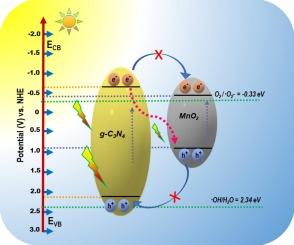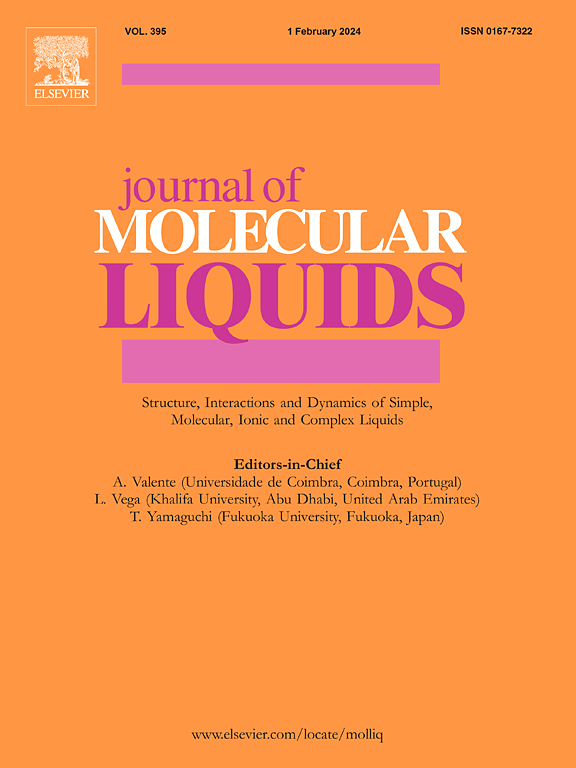Design of MnO2/g-C3N4 heterojunction composite photocatalysts for augmented charge separation and photocatalytic degradation performance with superior antibacterial activity
IF 5.3
2区 化学
Q2 CHEMISTRY, PHYSICAL
引用次数: 0
Abstract
The development of advanced photocatalysts is critical for addressing environmental pollution and enhancing water purification processes. Our study has effectively developed a novel MnO2/g-C3N4 (MGC) heterojunction composite photocatalyst exhibiting superior photo-degradation under visible-light (VL) conditions and also established antibacterial activities. Comprehensive characterization was acquired using XRD, FT-IR, FE-SEM with EDX-associated mapping images, TEM, UV–Vis DRS and PL investigations, indicating the successful formation of well-dispersed MnO2 nanoparticles (NPs) over the g-C3N4 catalyst. The MGC composite heterojunction photocatalyst demonstrated increased photocatalytic degradation activity of 77.2 % in aqueous crystal violet (CV) under VL within 120 min, significantly outperforming pure g-C3N4 and MnO2 by 3.02 and 2.37 times, respectively. The MGC composite demonstrates remarkable stability and reusability, retaining 73.7 % of its efficiency after five consecutive cycles. Additionally, the as-synthesised composite endows potent antibacterial action against various pathogenic bacteria including K. pneumonia, S. aureus, E. coli and B. cereus. The active species analysis indicates that the composite photocatalyst facilitates charge transfer, while effectively preventing the recombination of photo-produced carriers via an effective Z-scheme mechanism, and the synergistic things among MnO2 and g-C3N4 are accredited to the boosted photocatalytic and antibacterial activities. This research describes a photocatalytic approach for efficiently eliminating various contaminants from water bodies, which has significant implications for the future development of photocatalytic technology for wastewater handling.

设计 MnO2/g-C3N4 异质结复合光催化剂,提高电荷分离和光催化降解性能,并具有优异的抗菌活性
开发先进的光催化剂对于解决环境污染问题和提高水净化工艺至关重要。我们的研究有效地开发出了一种新型 MnO2/g-C3N4 (MGC) 异质结复合光催化剂,它在可见光(VL)条件下具有优异的光降解性能,同时还具有抗菌活性。利用 XRD、傅立叶变换红外光谱、带有 EDX 相关绘图图像的 FE-SEM、TEM、UV-Vis DRS 和 PL 研究进行了综合表征,结果表明在 g-C3N4 催化剂上成功形成了分散良好的 MnO2 纳米颗粒 (NPs)。在 VL 条件下,MGC 复合异质结光催化剂在 120 分钟内对水性水晶紫(CV)的光催化降解活性提高了 77.2%,分别是纯 g-C3N4 和 MnO2 的 3.02 倍和 2.37 倍。MGC 复合材料具有出色的稳定性和可重复使用性,在连续使用五个周期后仍能保持 73.7% 的效率。此外,合成的复合材料对肺炎金葡菌、金黄色葡萄球菌、大肠杆菌和蜡样芽孢杆菌等多种病原菌具有很强的抗菌作用。活性物种分析表明,复合光催化剂促进了电荷转移,同时通过有效的 Z 型机制有效地防止了光生载流子的重组,而 MnO2 和 g-C3N4 之间的协同作用则是提高光催化和抗菌活性的原因。这项研究描述了一种高效消除水体中各种污染物的光催化方法,对未来废水处理光催化技术的发展具有重要意义。
本文章由计算机程序翻译,如有差异,请以英文原文为准。
求助全文
约1分钟内获得全文
求助全文
来源期刊

Journal of Molecular Liquids
化学-物理:原子、分子和化学物理
CiteScore
10.30
自引率
16.70%
发文量
2597
审稿时长
78 days
期刊介绍:
The journal includes papers in the following areas:
– Simple organic liquids and mixtures
– Ionic liquids
– Surfactant solutions (including micelles and vesicles) and liquid interfaces
– Colloidal solutions and nanoparticles
– Thermotropic and lyotropic liquid crystals
– Ferrofluids
– Water, aqueous solutions and other hydrogen-bonded liquids
– Lubricants, polymer solutions and melts
– Molten metals and salts
– Phase transitions and critical phenomena in liquids and confined fluids
– Self assembly in complex liquids.– Biomolecules in solution
The emphasis is on the molecular (or microscopic) understanding of particular liquids or liquid systems, especially concerning structure, dynamics and intermolecular forces. The experimental techniques used may include:
– Conventional spectroscopy (mid-IR and far-IR, Raman, NMR, etc.)
– Non-linear optics and time resolved spectroscopy (psec, fsec, asec, ISRS, etc.)
– Light scattering (Rayleigh, Brillouin, PCS, etc.)
– Dielectric relaxation
– X-ray and neutron scattering and diffraction.
Experimental studies, computer simulations (MD or MC) and analytical theory will be considered for publication; papers just reporting experimental results that do not contribute to the understanding of the fundamentals of molecular and ionic liquids will not be accepted. Only papers of a non-routine nature and advancing the field will be considered for publication.
 求助内容:
求助内容: 应助结果提醒方式:
应助结果提醒方式:


